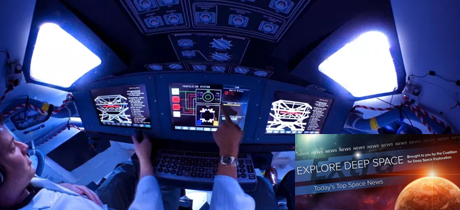In Today’s Deep Space Extra… Electronics aboard NASA’s Orion spacecraft lit up Tuesday at NASA’s Kennedy Space Center, where contractor Lockheed Martin is preparing the capsule for a future test flight atop the Space Launch System rocket.
Human Space Exploration
NASA powers up spacecraft that could one day carry humans to Mars
Coalition Member in the News
CNN Money (8/22): Orion, the human spacecraft that Lockheed Martin is developing for future NASA missions of human deep space exploration, was powered up in its latest configuration on Tuesday at the Kennedy Space Center. The capsule is undergoing preparations for Exploration Mission-1 (EM-1), an unmanned test flight that will send the capsule around the moon and back to Earth for re-entry, ocean splashdown and recovery. NASA is evaluating a launch date for EM-1, which will pair Orion with the Space Launch System rocket.
3-D printing and in-orbit manufacturing promise to transform space missions
Coalition Member in the News
Space News (8/22 on line; 7/17 in print): California based Made in Space, Inc., may be changing the way space hardware launches and reaches its destinations with demonstrations of 3-D printing, or additive manufacturing, aboard the International Space Station.
ESA issues call for Deep Space Gateway (DSG) research ideas
Spacepolicyonline.com (8/22): The European Space Agency (ESA) issued a call for proposals today seeking ideas for research that could be conducted on a Deep Space Gateway (DSG) in cis-lunar space. They will be discussed at a December ESA workshop. NASA is developing the DSG concept, but the Trump Administration did not include any funding for it in NASA’s FY2018 budget request.
The Space Review (8/22): Legends of the Apollo era were among those gathered in Oshkosh, Wisconsin, last month for the annual Experimental Aircraft Association gathering. They recounted humanity’s first steps into space, following a demonstration by the Navy’s Blue Angels. “These special people still have plenty to teach us. Everyone is still bright and articulate. Nobody else yet has these kinds of experiences. These are the shoulders we are standing upon as we move out there,” writes Eric Hedman, Design Logic’s chief technology officer, in an op-ed.
U.S. Army vet, Floridian set to start astronaut training
Orlando Sentinel (8/22): This week, twelve U.S. and two Canadian citizens assembled at NASA’s Johnson Space Center in Houston to begin two years of training for their respective space agencies’ astronaut corps. “Many of us dream of the opportunity to go into space and have that unique experience,” said Frank Rubio, a U.S. Army special forces medical doctor whose family is from El Salvador. “Many of us dream of the opportunity to go into space and have that unique experience,” said Rubio. “For me, it was just as much that as it was about participating in something that, in the big picture, I can be a part of that helps humanity and moves it forward.”
Space Science
The solar eclipse is over, but scientists will be studying it for years
USA Today (8/22): Scientists could spend years analyzing the data they gathered from Monday’s total solar eclipse. Their focus is on new imagery of the sun’s corona, or atmosphere, which was visible to scientists while the moon blocked the bright disk of the sun.
Study of moon rocks suggest interior of the moon is really dry
Universe Today (8/22): Studies of the water abundance on the moon seem to sway between a lot and very little. A new study led by a researcher from the Scripps Institution of Oceanography in California points toward the dry side. The findings are based on a major collision with the Earth by a large object that is believed to have cleaved off material that contributed to the moon’s formation early in the solar system’s history. Lunar water is considered a resource for future human exploration and development of the moon.
The asteroid that killed the dinosaurs caused catastrophic climate change
Seeker.com (8/22): Possibly the biggest swing in the Earth’s habitability can be traced to an impact from a six-mile-wide asteroid that struck the Yucatan Peninsula in Mexico about 65 million years ago. The blast threw so much debris high into the atmosphere that temperatures dropped significantly on a global scale. The dinosaurs were among the casualties. New findings on the impact of the asteroid strike are published in the proceedings of the National Academy of Sciences.

